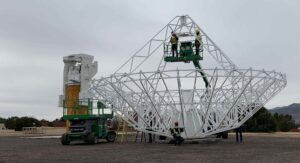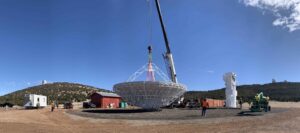Geodetic Very Long Baseline Interferometry (VLBI)
The Geodetic VLBI Technique
VLBI is a geometric technique that uses large radio telescopes separated by thousands of kilometers to observe natural radio sources (quasars) that are located billions of light-years from the Earth. These are the same kinds of instruments that are used for deep space tracking of spacecraft or radio astronomy, but the interest here is their applications for geodesy. Quasars are used because they are so far away that they have no significant apparent motion; they appear fixed in space and provide the most stable celestial reference frame that currently can be defined.

VLBI at MGO. Image credit: E. Terrazas
The VLBI technique, illustrated below, is the measurement of the same natural radio noise signal from a quasar at each antenna in operation (a minimum of 2). Multiple quasars may be observed during a session. These signals are recorded and sent to a correlation center where the two signals are compared and the time difference between the signal arrival at the two antennas is determined. Multiplied by the speed of light, this gives the geometric distance along the line of sight to the quasar. As the Earth rotates, the baseline distances between antennas can be recovered, along with the orientation of those baselines in space (precession, nutation and Earth rotation). Combined with GNSS data, VLBI also provides polar motion.

Geodetic VLBI Technique. Image credit: NASA Space Geodesy Project
MGO VLBI Instrument Capabilities
- 12-m fast-slewing radio telescope antenna
- 2-14 GHz band (four windows)
- 4 picosecond time-delay observations
- Operational in conjunction with Goddard Geophysical and Astronomical Observatory (GGAO) in Maryland, Kokee Park Geophysical Observatory (KPGO) in Hawaii, and other existing and anticipated geodetic VLBI systems within the emerging VLBI Global Observing System (VGOS)
Location: Behind the Frank N. Bash Visitor’s Center at McDonald Observatory
Foundation completed: September 2018
Antenna installed: December 2018
Operational Readiness: June 2019
First light: July 19, 2019
Watch the MGO VLBI antenna as it observes multiple quasars during a 24-hour session. Video credit: E. Terrazas
Construction of MGO’s Geodetic VLBI System

Construction and assembly of VLBI antenna tower. Image credit: E. Terrazas

Construction and assembly of VLBI antenna tower and antenna. Image credit: E. Terrazas

Construction and assembly of VLBI antenna tower and antenna at a different angle. Image credit: E. Terrazas

Construction and assembly of VLBI antenna tower and closer view of the antenna. Image credit: E. Terrazas

Construction and assembly of VLBI antenna tower and closer view of the antenna. Image credit: E. Terrazas

Lifting the antenna. Image credit: E. Terrazas

Antenna being lowered on to antenna tower. Image credit: E. Terrazas

Antenna being lowered on to antenna tower. Image credit: E. Terrazas

Image credit: E. Terrazas

Assembled VLBI. Image credit: E. Terrazas

VLBI at MGO from a far. Image credit: E. Terrazas
For additional information: